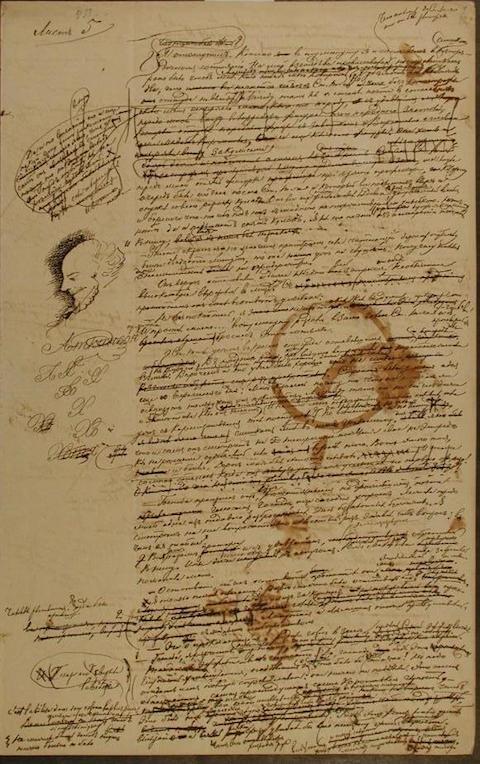
Dostoevsky, a doodler? Surely not! Great Russian brow furrowed over the meaning of love and hate and faith and crime, diving into squalid hells, ascending to the heights of spiritual ecstasy, taking a gasp of heavenly air, then back down to the depths again to churn out the pages and hundreds of character arcs—that’s Dostoevsky’s style. Doodles? No. And yet, even Dostoevsky, the acme of literary seriousness, made time for the odd pen and ink caricature amidst his bouts of existential angst, poverty, and ill health. We’ve shown you some of them before—indeed, some very well rendered portraits and architectural drawings in the pages of his manuscripts. Now, just above, see yet another, a recently discovered tiny portrait of Shakespeare in profile, etched in the margins of a page from one of his angstiest novels, The Possessed, available in our collection, 800 Free eBooks for iPad, Kindle & Other Devices.

Annie Martirosyan in The Huffington Post points out some family resemblance between the Shakespeare doodle and the famous brooding oil portrait of Dostoevsky himself, by Vasily Perov. She also notes the ring stain and sundry drips over the “hardly legible… scribbles” and “marginalia… scattered naughtily across the page” is from the author’s tea. “Feodor Mikhailovich was an avid tea drinker,” and he would consume his favorite beverage while walking “to and fro in the room and mak[ing] up his characters’ speeches out loud….” Can’t you just see it? Under the drawing (see it closer in the inset)—in one of the many examples of the author’s painstaking handwriting practice—is the name “Atkinson.”
Martirosyan sums up a somewhat complicated academic discussion between Dostoevsky experts Vladimir Zakharov and Boris Tikhomirov about the source of this name. This may be of interest to literary specialists. But perhaps it suffices to say that both scholars “have now confirmed the authenticity of the image as Dostoevsky’s drawing of Shakespeare,” and that the name and drawing may have no conceptual connection. It’s also further proof that Dostoevsky, like many of us, turned to making pictures when, says scholar Konstantin Barsht—whom Colin Marshall quoted in our previous post—“the words came slowest.” In fact, some of the author’s character descriptions, Barsht claims, “are actually the descriptions of doodled portraits he kept reworking until they were right.”
So why Shakespeare? Perhaps it’s simply that the great psychological novelist felt a kinship with the “inventor of the human.” After all, Dostoevsky has been called, in those memorable words from Count Melchoir de Vogue, “the Shakespeare of the lunatic asylum.”
h/t OC reader Nick
Related Content:
Fyodor Dostoevsky Draws Elaborate Doodles In His Manuscripts
Watch a Hand-Painted Animation of Dostoevsky’s “The Dream of a Ridiculous Man”
Josh Jones is a writer and musician based in Durham, NC. Follow him at @jdmagness


…In Just 4 Weeks!
If You Are A Beginner Or Intermediate Artist Who Struggles With:
- Keeping Your Portrait In Proportion…
- Adding Depth Using Realistic Shading…
- Or Capturing The Likeness Of Your Portrait…
…Then This Will Be The Most Important Letter You Ever Read!